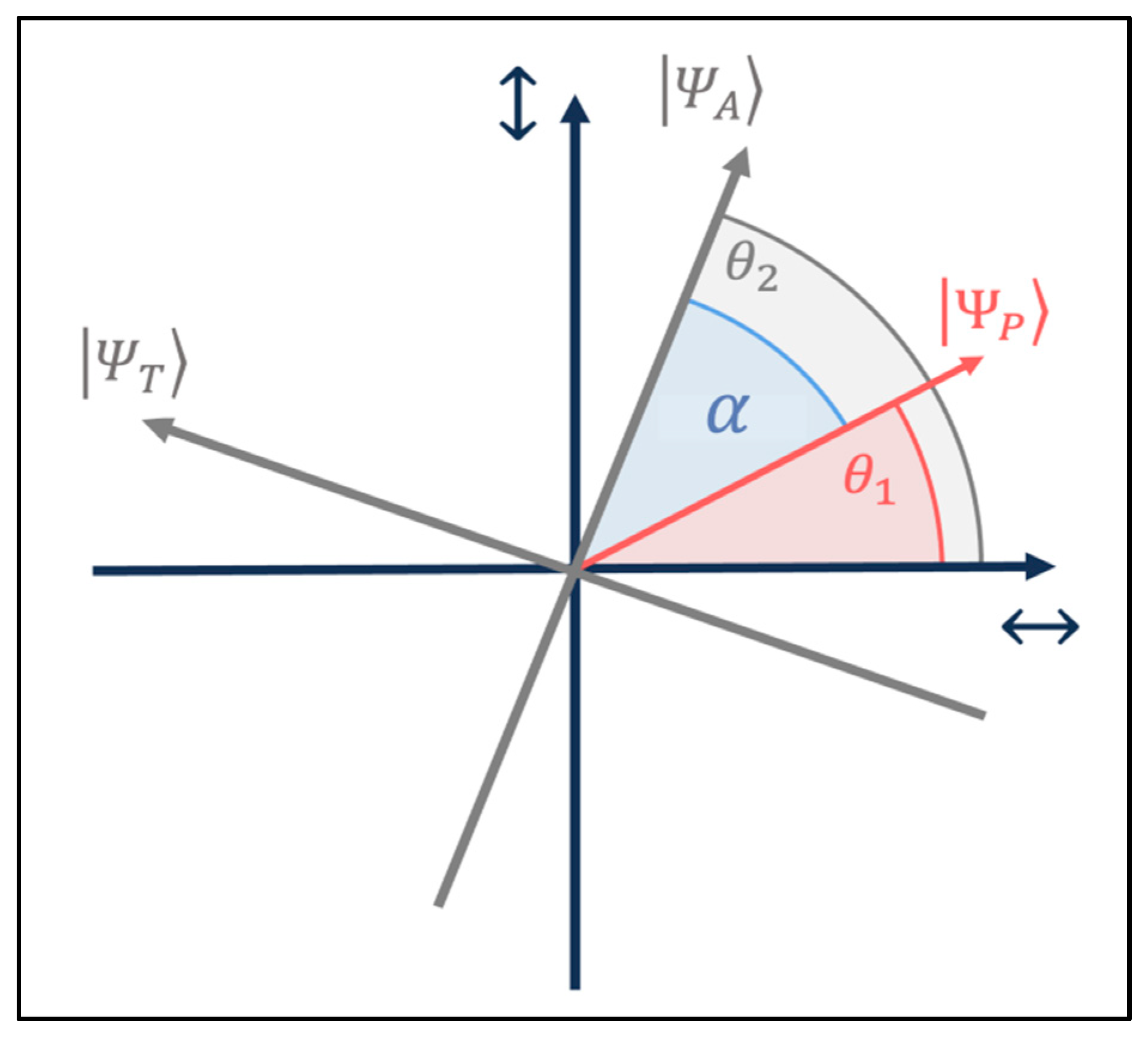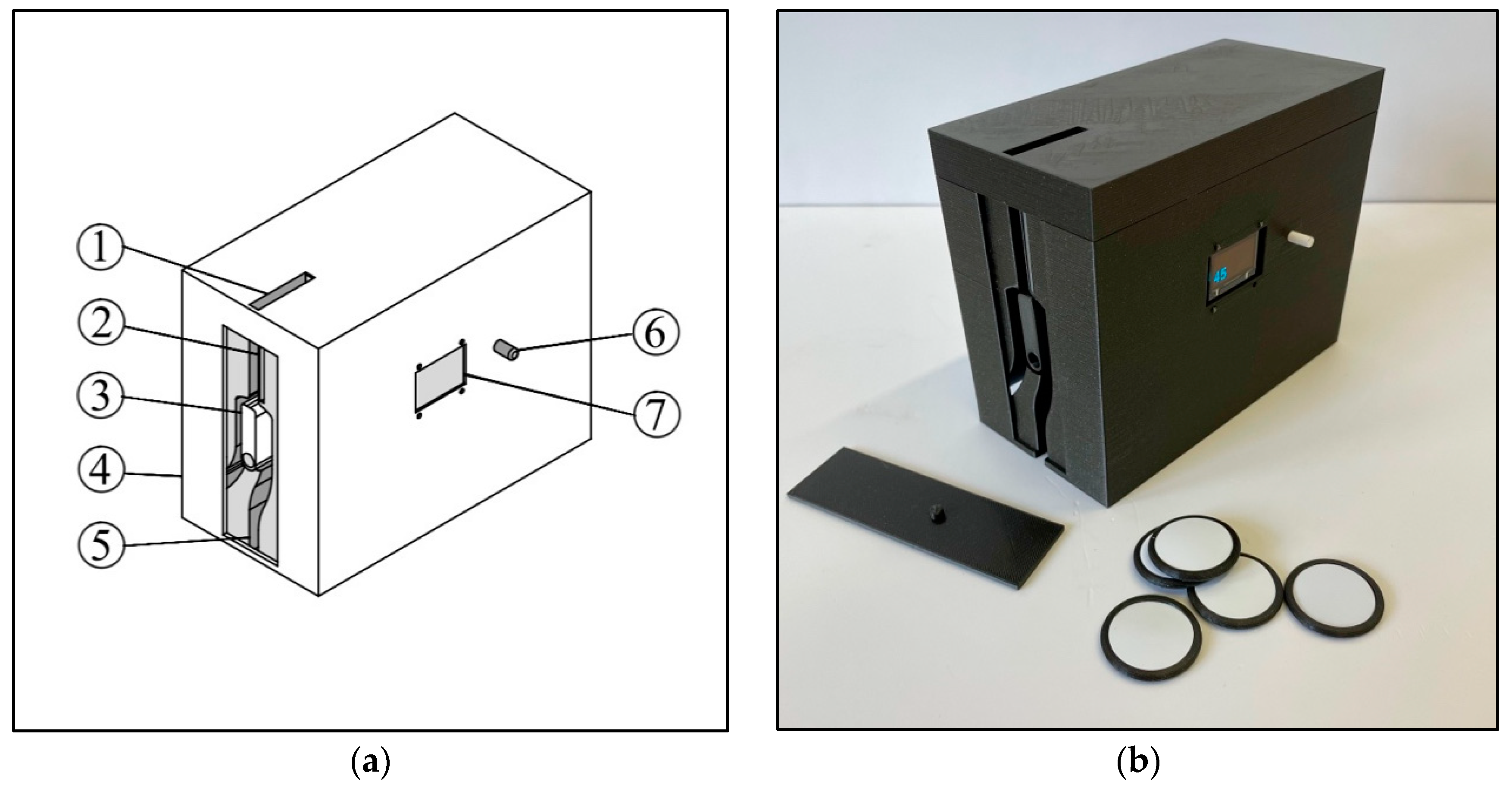An Approach to Quantum Physics Teaching through Analog Experiments
Abstract
:1. Introduction
2. Analog Experiment: Polarization Modules
2.1. Comparison of Quantum and Classical Polarization from a Teaching Perspective
2.1.1. Classical Perspective
2.1.2. Quantum Perspective
2.2. Polarization Analogy Module
2.3. Polarization Analogy and Reasoning Tools
2.3.1. Conceptualization of a Students’ Laboratory
- Rule 1—Statistical Behavior. Single events are not predictable; they are random. Only statistical predictions (for many repetitions) are possible in quantum physics.
- Rule 2—Unique Measurement Results. Even if quantum objects in a superposition state need not have a fixed value of the measured quantity, one always finds a unique result upon measurement.
- Rule 3—Ability to Interfere. Interference occurs if there are two or more “paths” leading to the same experimental result. Even if these alternatives are mutually exclusive in classical physics, none of them will be “realized” in a classical sense.
- Rule 4—Complementarity. Exemplary formulations are: “which path information and interference pattern are mutually exclusive” or “quantum objects cannot be prepared for position and momentum simultaneously”.
2.3.2. Results and Students’ Evaluation
3. A Hidden Parameter and Hardy’s Experiment
3.1. Nonlocality for Two Particles without Inequalities for Almost All Entangled States
3.2. Didactical Framework
4. Conclusions
Author Contributions
Funding
Data Availability Statement
Conflicts of Interest
References
- Einstein, A.; Podolsky, B.; Rosen, N. Can quantum-mechanical description of physical reality be considered complete? Phys. Rev. 1935, 47, 777–780. [Google Scholar] [CrossRef] [Green Version]
- Müller, R. Quantenphysik in der Schule; Logos Verlag: Berlin, Germany, 2000. [Google Scholar]
- Norsen, T. Foundations of Quantum Mechanics: An Exploration of the Physical Meaning of Quantum Theory; Springer International Publishing AG: Cham, Switzerland, 2017; Available online: https://link.springer.com/book/10.1007/978-3-319-65867-4 (accessed on 10 September 2022).
- Bricmont, J. Making Sense of Quantum Mechanics; Springer International Publishing Switzerland: Cham, Switzerland, 2016. [Google Scholar] [CrossRef]
- Dürr, D.; Lazarovici, D. Understanding Quantum Mechanics: The World According to Modern Quantum Foundations; Springer Nature Switzerland: Cham, Switzerland, 2020. [Google Scholar] [CrossRef]
- Feynman, R.P.; Leighton, R.B.; Sands, M. The Feynman Lectures on Physics, Volume III: Quantum Mechanics; Basic Books: New York, NY, USA, 2011; Available online: https://feynmanlectures.caltech.edu/III_toc.html (accessed on 10 September 2022).
- Greinert, F.; Müller, R.; Bitzenbauer, P.; Ubben, M.; Weber, K.-A. Requirements for future quantum workforce—A Delphi study. J. Phys. Conf. Ser. 2022, 2297, 012017. [Google Scholar]
- Pospiech, G. Quantencomputer & Co.: Grundideen und Zentrale Begriffe der Quanteninformation Verständlich Erklärt; Springer Spektrum: Wiesbaden, Germany, 2021. [Google Scholar] [CrossRef]
- Heusler, S.; Schlummer, P.; Ubben, M. The topological origin of quantum randomness. Symmetry 2021, 13, 581. [Google Scholar] [CrossRef]
- Aehle, S.; Cartarius, H. Didaktische Ansätze für Quantum Random Number Generators (QRNG). PhyDid B—Didakt. Phys.—Beiträge DPG-Frühjahrstagung 2021, virtuell, 489–493. Available online: https://ojs.dpg-physik.de/index.php/phydid-b/article/view/1146 (accessed on 10 September 2022).
- Bitzenbauer, P.; Meyn, J. A new teaching concept on quantum physics in secondary schools. Phys. Educ. 2020, 55, 055031. [Google Scholar] [CrossRef]
- Scheiger, P.; Nawrodt, R.; Cartarius, H. Interaktive und aktivierende Lehrkonzepte in der Theoretischen Physik. PhyDid B—Didakt. Phys.—Beiträge DPG-Frühjahrstagung 2020, Bonn. pp. 77–83. Available online: https://ojs.dpg-physik.de/index.php/phydid-b/article/view/1166 (accessed on 10 September 2022).
- Filk, T. Quantenmechanik (Nicht Nur) für Lehramtsstudierende; Springer Spektrum: Berlin/Heidelberg, Germany, 2019. [Google Scholar] [CrossRef]
- Pospiech, G.; Schöne, M. Teacher education in quantum physics—A proposal for improving content knowledge. In Electronic Proceedings of the ESERA 2019 Conference—The Beauty and Pleasure of Understanding: Engaging with Contemporary Challenges Through Science Education; Levrini, O., Tasquier, G.; Eds.; Bologna, Italy, 26–30 August 2019; Part 13: Pre-service Science Teacher Education; Evagorou, M., Jimenez Liso, M.R., Eds.; Alma Mater Studiorium/University of Bologna: Bologna, Italy, 2020; pp. 1452–1461. Available online: https://www.esera.org/publications/esera-conference-proceedings/esera-2019 (accessed on 10 September 2022).
- Weber, K.-A.; Friege, G.; Scholz, R. Quantenphysik in der Schule—Was benötigen Lehrkräfte? Ergebnisse einer Delphi-Studie. Zeit. Didaktik Naturwis.—ZfDN 2020, 26, 173–190. [Google Scholar] [CrossRef]
- Ivanjek, L.; Shaffer, P.; Planinic, M.; McDermott, L. Probing student understanding of spectra through the use of a typical experiment used in teaching introductory modern physics. Phys. Rev. Phys. Educ. Res. 2020, 16, 010102. [Google Scholar] [CrossRef] [Green Version]
- Greinert, F.; Müller, R. Playing with a quantum computer. arXiv 2021, arXiv:2108.06271. [Google Scholar] [CrossRef]
- Schlummer, P.; Laustöer, J.; Schulz-Schaeffer, R.; Abazi, A.; Schuck, C.; Pernice, W.; Heusler, S.; Laumann, D. MiReQu—Mixed Reality Lernumgebungen zur Förderung fachlicher Kompetenzentwicklung in den Quantentechnologien. PhyDid B—Didakt. Phys.—Beiträge DPG-Frühjahrstagung 2020, Bonn, 451–459. Available online: https://ojs.dpg-physik.de/index.php/phydid-b/article/view/1044 (accessed on 10 September 2022).
- Donhauser, A.; Bitzenbauer, P.; Meyn, J.-P. Von Schnee-und Elektronenlawinen: Entwicklung eines Erklärvideos zu Einzelphotonendetektoren. PhyDid B—Didakt. Phys.—Beiträge DPG-Frühjahrstagung 2020, Bonn, 235–240. Available online: https://ojs.dpg-physik.de/index.php/phydid-b/article/view/1021 (accessed on 10 September 2022).
- Novak, M.; Schwan, S. Does Touching Real Objects Affect Learning? Educ. Psychol. Rev. 2021, 33, 637–665. [Google Scholar] [CrossRef]
- Chatterjee, H.J.; Hannan, L.; Thomson, L. An introduction to object-based learning and multisensory engagement. In Engaging the Senses: Object-Based Learning in Higher Education; Chatterjee, H.J., Hannan, L., Eds.; Routledge: New York, NY, USA, 2015; pp. 1–18. [Google Scholar] [CrossRef]
- Moreno, R.; Mayer, R. Interactive Multimodal Learning Environments. Educ. Psychol. Rev. 2007, 19, 309–326. [Google Scholar] [CrossRef]
- Kircher, E.; Girwidz, R.; Fischer, H. Physikdidaktik: Grundlagen; Springer Spektrum: Berlin/Heidelberg, Germany, 2020. [Google Scholar] [CrossRef]
- Küblbeck, J.; Müller, R. Die Wesenszüge der Quantenphysik: Modelle, Bilder, Experimente; Aulis Verlag Duebne GmbH & Co KG: Cologne, Germany, 2003. [Google Scholar]
- Hardy, L. Nonlocality for two particles without inequalities for almost all entangled states. Phys. Rev. Lett. 1993, 71, 1665–1668. [Google Scholar] [CrossRef] [PubMed] [Green Version]
- Stadermann, H.K.E.; van den Berg, E.; Goedhart, M.J. Analysis of secondary school quantum physics curricula of 15 different countries: Different perspectives on a challenging topic. Phys. Rev. Phys. Educ. Res. 2019, 15, 010130. [Google Scholar] [CrossRef] [Green Version]
- Müller, R.; Mishina, O. Milq—Quantum physics in secondary school. In Teaching-Learning Contemporary Physics. Challenges in Physics Education; Jarosievitz, B., Sükösd, C., Eds.; Springer: Cham, Switzerland, 2021; pp. 33–45. [Google Scholar] [CrossRef]
- Passon, O.; Grebe-Ellis, J. Was ist eigentlich ein Photon? Prax. Naturwis. (PdN)—Phys. Schule 2015, 64, 46–48. Available online: https://www.physikdidaktik.uni-wuppertal.de/fileadmin/physik/didaktik/Forschung/Publikationen/Passon/Passon_Grebe-Ellis_2015_Moment_mal_was_ist_eigentlich_ein_Photon.pdf (accessed on 10 September 2022).
- Merzbacher, E. Quantum Mechanics; Wiley International Edition: New York, NY, USA, 1970. [Google Scholar]
- Tim Maudlin, J. What Bell did. Phys. A Math. Theor. 2014, 47, 424010. [Google Scholar] [CrossRef]
- Goldstein, S.; Norsen, T.; Tausk, D.V.; Zanghi, N. Bell’s theorem. Scholarpedia 2011, 6, 8378. [Google Scholar] [CrossRef]
- Bell, J.S. On the Einstein—Podolsky—Rosen paradox. Phys. Phys. Fiz. 1964, 1, 195–290. [Google Scholar] [CrossRef]



| Pre-Test | Post-Test | |||
|---|---|---|---|---|
| Absolute | Percentage | Absolute | Percentage | |
| Correct Answers | 56/110 | 51% | 75/110 | 68% |
| Incorrect Answers | 54/110 | 49% | 35/110 | 32% |
Publisher’s Note: MDPI stays neutral with regard to jurisdictional claims in published maps and institutional affiliations. |
© 2022 by the authors. Licensee MDPI, Basel, Switzerland. This article is an open access article distributed under the terms and conditions of the Creative Commons Attribution (CC BY) license (https://creativecommons.org/licenses/by/4.0/).
Share and Cite
Aehle, S.; Scheiger, P.; Cartarius, H. An Approach to Quantum Physics Teaching through Analog Experiments. Physics 2022, 4, 1241-1252. https://doi.org/10.3390/physics4040080
Aehle S, Scheiger P, Cartarius H. An Approach to Quantum Physics Teaching through Analog Experiments. Physics. 2022; 4(4):1241-1252. https://doi.org/10.3390/physics4040080
Chicago/Turabian StyleAehle, Stefan, Philipp Scheiger, and Holger Cartarius. 2022. "An Approach to Quantum Physics Teaching through Analog Experiments" Physics 4, no. 4: 1241-1252. https://doi.org/10.3390/physics4040080
APA StyleAehle, S., Scheiger, P., & Cartarius, H. (2022). An Approach to Quantum Physics Teaching through Analog Experiments. Physics, 4(4), 1241-1252. https://doi.org/10.3390/physics4040080





